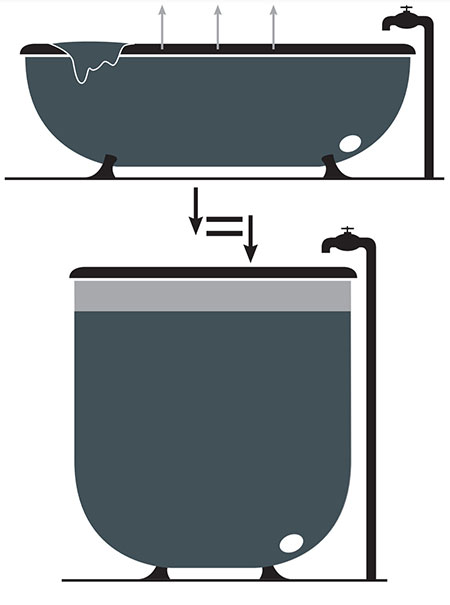

Increase the Size of Your Bathtub of Fitness
A metaphor to help understand training
Increase the Size of Your Bathtub of Fitness
A metaphor to help understand training
By PCG founder & CEO Hunter Allen
Back to list of our training, coaching and nutrition essays
Increasing the size of your bath tub.

Bill & Carol McGann's book The Story of the Tour de France, Vol 1, 1903 - 1975 is available as an audiobook here. Or, just click on the link to the right for print and eBook versions.

I am often asked many great questions. One of the questions that I am asked often is, “Which is better to improve your threshold power, riding longer rides or doing more intervals in shorter rides?” The great thing about being a cycling coach is that most, if not all, your answers to questions such as this are always: “It depends”…. Seriously though, there are times when you should do longer rides in order to improve your stamina and other times when you should do shorter, harder intensity rides to improve your absolute threshold number. How should you decide which you should do and when? Let’s first examine a metaphor that I like to teach at many of my power seminars in order to teach the importance of both types of rides and then dig deeper into the decision making process.
Let’s say for instance, that every cyclist has a “bathtub” of fitness. In your bathtub, you have a drain, bathtub walls, a spigot, and some Hot and Cold handles. Some cyclists have a very big bathtub but with small walls. These are the riders that can ride across the USA, with panniers and a tent, spending 12-14 hours rolling along at 14mph and seeing the sights over a summer. They have incredible endurance, but at a slow pace. They never “overflow” the walls of the bathtub because they just don’t ride at an intense enough pace to flood the massive floor of their bathtub. Then there are those that have two 50 gallon drums stacked on top of each other, tall walls but relatively small in volume. These are the sprinters on the track. Their bathtub can be “fire-hosed” for about a minute or two before it fills up and overflows onto the bathroom floor and since the drain is relatively small, they have to wait a while before they can “fire-hose” it again. Then there are the road racers and stage racers; they have both a relatively large bathtub with tall walls. These riders can handle a high flow of water into their bathtub and even some limited “fire hosing” as well. Ultimately, that’s what most of us want, the largest volume bathtub with the tallest walls. This would be the ultimate in the “bathtub” of fitness.

Tall bathtub

Normal bathtub

Short and wide bathub
Inside each bathtub, there is a drain that controls the flow of water out of the bathtub and the size of your “drain” is incredibly important to your ability to handle the water pouring into it. The larger the drain, the more work you can handle as a cyclist. In our metaphor, the drain is your aerobic efficiency, or how developed your cardiovascular system is within your body. The more developed your aerobic system, the larger the drain and the more you train and longer you have trained the larger the drain. Aerobic capacity and efficiency refers to the number of capillaries you have in your muscles, the number and size of the mitochondria in your cells, the stroke volume in your heart, the size of your heart and the maximized capacity of your lungs, along with many other factors. The bottom line is: the bigger your “drain”, the more efficient you are at riding at a higher intensity for a longer time, which is endurance or stamina. A road cyclist wants to first improve their drain and then begin working on improving the height of the walls in the bathtub. In order to do this, you must first “stress” the drain, by adding water pressure to it, which means you need to fill up the bathtub to at least three-fourths full and once you have enough water pressure on the drain, then you need to maintain it for as long as you can by keeping the water or “dose of training/watts” coming out of the spigot at the same rate as the water emptying out of the drain. The body senses this “stress” and responds by increasing the size of the drain. Any prolonged high-ish level of water in the bathtub, so to speak, will cause the drain size to increase. From a training perspective, this means riding at an upper tempo pace (85-95% of FTP, or Functional Threshold Power) will create enough water pressure on the drain to improve aerobic efficiency. This is really the first step towards increased fitness and if you are working on increasing your overall FTP. Train your drain first.

Bathtub three-fourths full
In order to increase the height of the walls in the bathtub, then you need to stress the current height of the walls. This is done by adding so much water to the bathtub that the water level goes over the edge and floods the floor of the bathroom or gets right up to the edge and threatens to flood. This type of stress means riding right at your threshold power or “on the edge” and also just above it, so that the water is constantly at its maximum capacity of the bathtub. The body responds to this type of stress, by increasing the height of the walls in order to prevent the water from escaping. Of course, you can train at Level 4 or your functional threshold power before you “train the drain”, and increase the height of the walls, but then you will be left with a small drain in relation to the walls. What this means in practical terms is that you will be able to ride at your threshold or slightly above for a 20-30 minute period and not much longer and then need to wait for a while (30 minutes or more) to allow the water to drain out, before having the ability to do another 20-30 minute threshold interval. If you haven’t figured it out yet, in our metaphor here, “water” is lactate in the blood.

Preventing the bathtub from overflowing
Can you do both things at once? Increase the height of your bathtub walls (FTP) and the size of your drain (aerobic efficiency/endurance)? Of course! One of the best ways to do this is by doing what I call the “Sweet Spot with Bursts” intervals. These intervals are correctly done when you ride for 20 minutes at your “Sweet Spot” (88-93% of FTP) and then every two minutes for the entire 20 minute period, you do a hard burst of effort up to 120% of FTP for 30 seconds and then recover back to sweet spot, but not lower. This is like filling the bathtub about 3/4 full, then taking a fire hose and blasting water into the tub for 30 seconds, just enough to get the water to the top and overflowing into the floor and then shutting off the fire hose. Once the water drains back down to 3/4 full again, you “fire hose” it again! By doing this, you increase the water pressure on the drain and at the same time you increase the height of the walls in the bathtub, hereby increasing both FTP and endurance.

Fire hoseing the bathtub
Now, back to our original question of when should you work on which of the two components of the “Bathtub of Fitness”? I will always say that you should increase the size of your drain first (endurance/aerobic efficiency) and then work on the height of the walls (FTP) second. This is the general progression in periodization to begin with and it allows you to build a solid foundation of fitness, and increasing your FTP after you have established that initial level of fitness. Once you are in the racing season or in the middle of the summer, then you might consider working on the height of the walls first. As you probably know, your FTP and endurance increase and decrease in a wave like pattern through the season and if you are in the middle of the season and have just come off a long block of hard racing, you might best be served by continuing to work on the height of walls (FTP), instead of going back to increasing the size of the drain.
The key to doing this making sure that limit these intense workouts to only two a week. If you do too much of the FTP work, then the size of the drain will begin to shrink and while you’ll have great form for criterium racing, you’ll be toast after an hour and half in a road race. So, conversely, if you just have finished a week long criterium series with tons of FTP work, then I would suggest working on your endurance (drain) in order to prepare yourself for any longer rides. Yet another scenario might be that you have a strong spring of racing and riding, and then decide to take a break for a month or two afterward, just riding casually and not doing any specific training. In the late summer and early fall you decide you want to race in Cyclo-cross races and perform well. In this case, I would work the “drain” first for at least 2-3 weeks, and then do a week of intensity, working on FTP and then back to the drain for 2 more weeks and finishing with 2 weeks of working heavily on FTP (height of the walls).
When in doubt of which to do first, then fall back on working on your endurance/aerobic efficiency and then only when you feel you have done enough work improving the size of your drain, then move onto increasing the height of the walls or work done right at your FTP. The “bathtub of fitness” is a key concept to understand for sustained and solid improvement season after season and year over year. As you progress through your season, making sure you are working on the correct component is always essential to continued growth and hopefully now you have a better understanding of which part of the bathtub is the most important for you.
Hunter Allen is a USA Cycling Level 1 coach and former Professional Cyclist. He is the co-author of “Training and Racing with a Power Meter, co-developer of TrainingPeaks WKO+ Software, and is the CEO and Founder of the Peaks Coaching Group. He specializes in coaching cyclists with wattage meters and is on the forefront coaching with cycling’s newest tool. Hunter and his coaches at PCG coach athletes of all fitness levels and you can contact Hunter directly at info@peakscoachinggroup.com
.








